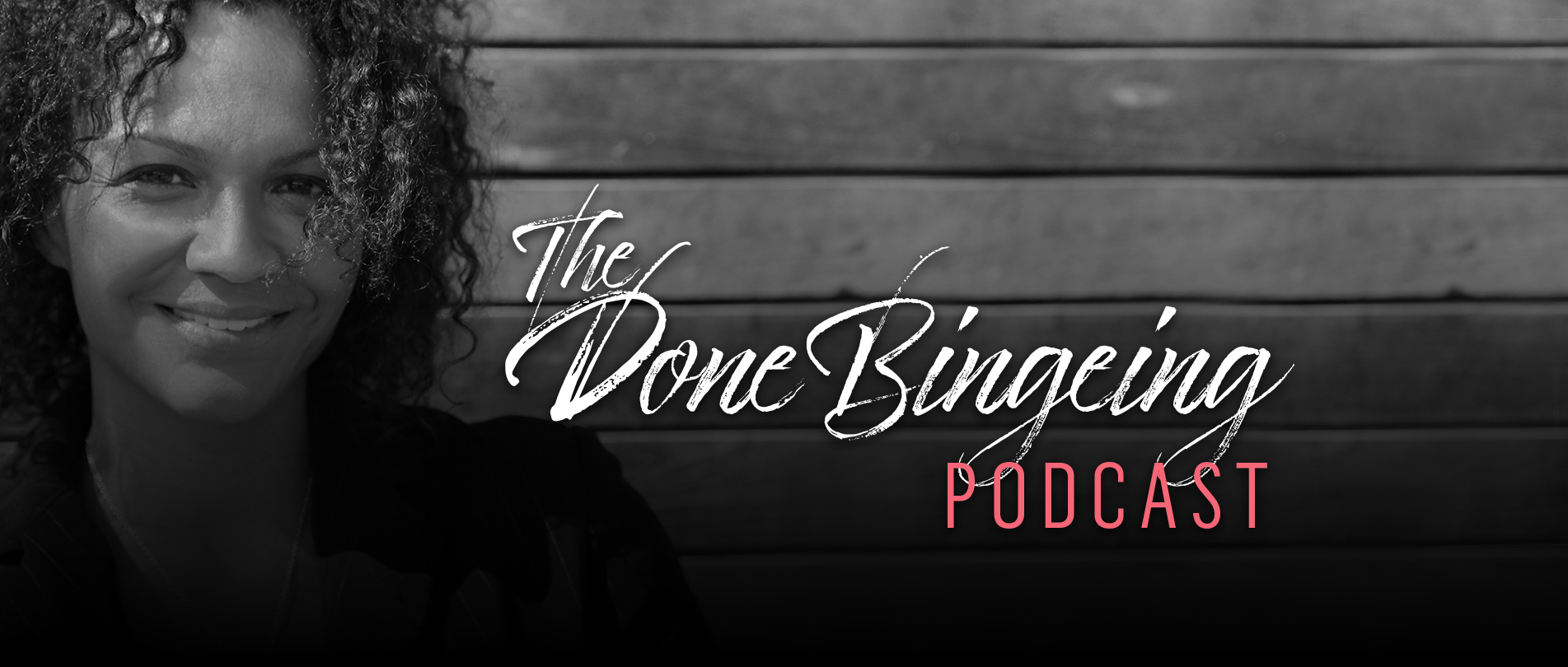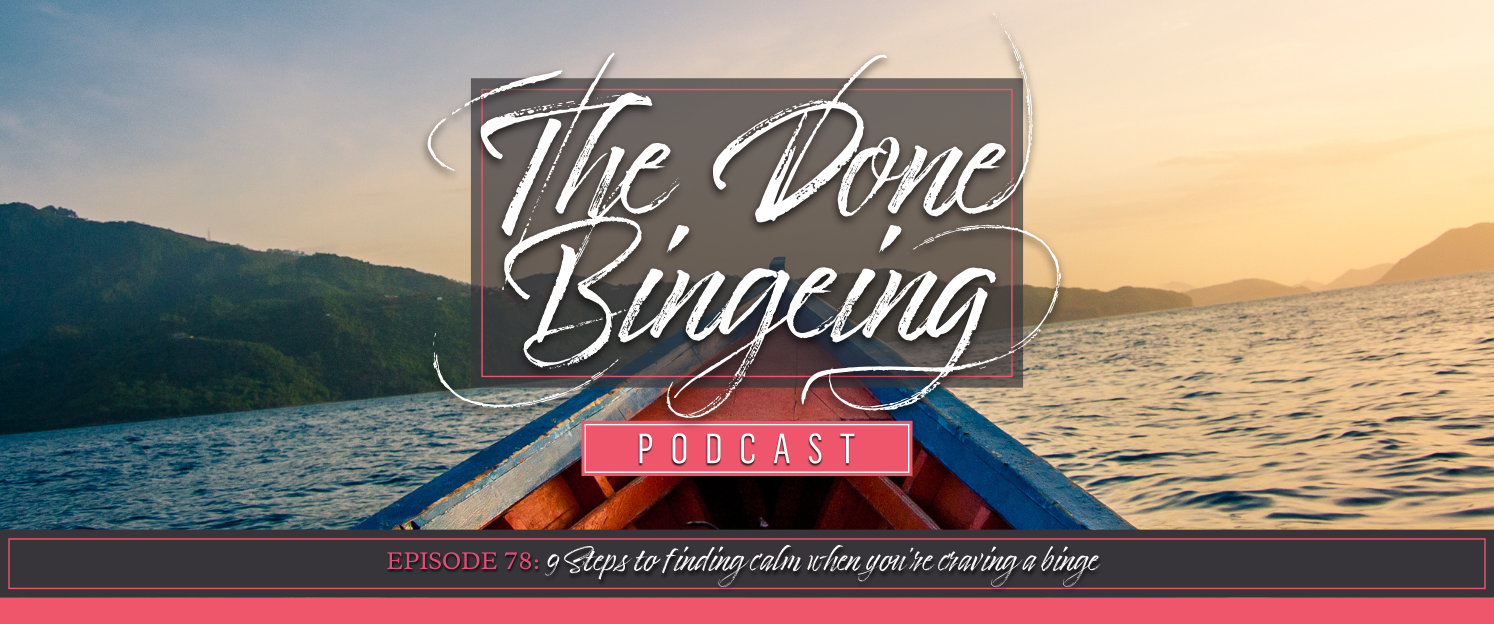
EP #78: 9 steps to finding calm when you’re craving a binge

“How do I deal with the urge to binge?” It’s one of the most common questions I get asked.
The experience of the urge can be incredibly tough, scary even. But you’re not alone in this. I’ve put together this episode with nine actionable steps to help you navigate those moments when the urge to binge eat feels overwhelming.
In episode 78, I share nine actionable steps to help you when you’re experiencing urges and cravings, including part of Stephen Porges’ Polyvagal Theory. Get full show notes and more information here: https://www.holdingthespace.co/78.
And here’s the cherry on top: I’ve created a special resource called, Calm in the Crave: Your Pocket Pal When You Need It, just for you. It summarizes everything we’ll discuss here, so you can have it handy whenever you need it. Head over to https://www.holdingthespace.co/calm to download it.
Episode: Play in new window Subscribe: Apple Podcasts | Google Podcasts | Spotify | iHeartRadio | Amazon Music | Deezer | RSS
- Stephen Porges’ Polyvagal Theory
- Calm in the Crave: Your Pocket Pal When You Need It
- If you’re interested in one-on-one support, book your free, 30-minute consultation with me here!
- Join Done Bingeing on social: Instagram | Facebook | Pinterest | LinkedIn
Download the full transcript
View the full transcript
What do a wind break and a thank you card have to do with you and binge eating? Keep listening.
Welcome to The Done Bingeing Podcast. This is the place to hear about how you compare the emerging brain science about why you binge with powerful life coaching to help you stop. If you want to explore an evidence-based non-clinical approach to end binge eating, you are in the right place.
It’s time to free yourself. You have more power than you know. To find out more, go to www.holdingthespace.co and click programs. And now your host, Internal Family Systems, level 3 trained and master coach certified Martha Ayim.
Hey you. It is great to be back. How are you? How are you doing? We are leaning into April and the first three months of this year have gone by so crazily quickly.
I’m so delighted to be back with you in this episode. I want to address what so many people ask me again and again.
What do I do when I feel the urge to binge?
You know, when something’s happening for us, it can feel really hard. Having cravings to binge eat or urges to binge eat can feel really, really hard, so I created this episode for moments just like this. Even though I might not be with you physically—with my body—I could be in your ear. I’m physically not there. but spiritually I’m pretty close.
If that feels right for you, we’re not meant to go through tough times alone. I’m with you in spirit, and I’m by your side with tenderness.
You don’t have to go through this alone and that’s why I created this episode. So what I am going to share with you are nine steps to help you when you feel the urge to binge. And I want to tell you that I have created a very special resource for you that you can download. If you go to https://www.holdingthespace.co/calm, you’ll be able to download a resource I have for you that summarizes everything I’m about to talk about.
So please don’t worry about trying to capture it all or write notes. I’m going to have a resource there for you. And it’s called Calm in the Crave. And it’s going to capture the essence of what I’m going to offer here in this episode.
Step One: Sail to safe harbor
You know, when I was, when did I start going to summer camp or I should say, when did my parents start sending me to summer camp?
I went to a camp and it was on a lake and I learned to sail there. From there I sailed for several years, even after I left the camp. When I would catch a wind break, it was like heaven in the air, heaven with wind. I could sail and move on the water if I could just get the sails to catch that break of wind.
It was such a beautiful experience, so I call step one, sailing to safe harbor because it reminds me of those moments where my sails caught that wind break. And off we went.
Stephen Porges holds a Polyvagal Theory. In that theory, he teaches that one way we can navigate toward an inner sense of safety, a neurological state of safety is by exhaling for longer than we inhale.
You might wanna try this now, breathing through your nose, inhaling for four seconds and then exhaling for six seconds. And just check with yourself, “Is this the right time to do this?”
It might not be. And you might want to just listen to the directions for now.
And then another time when the timing feels right, you can try this out, inhaling through your nose for four seconds and exhaling for six seconds.
The first time I tried that I was like, okay, when I inhale for four, I exhale for four. How am I gonna hold onto this breath? So I’d hold my breath for two seconds and then I’d let it out for four seconds.
And then I remembered all my years in yoga and ocean breath or ujjayi breath, you might remember that this breath is characterized by a soft hissing sound at the back of the throat. And it sounds like the ocean. So one of the moments that mesmerized me so much was when I put my ear into a shell, and I heard the ocean in the shell. I couldn’t believe that that sound was there. That’s what calls to me most when I do this breath.
So sometimes it can sound like this. [Martha exhales using ujjayi breath.]
Can you hear that? It’s like an ocean breath. So you inhale for four seconds and exhale for six. And if you do this, inhale for four, exhale for six. That’s 10 seconds. You’ll have six iterations of this in every minute. And you can try this even just for two minutes.
You know, there are other things that help to prolong the exhale. One of them is humming, another one is singing.
Now, I’m not gonna hum for you here unless you really write in and tell me, “Martha, I want you to hum.”
Then I’m definitely gonna hum for you.
I’m not going to sing unless you write in again and tell me, “Martha, I want you to sing.” Then I’m going sing for you.
But those are other ways that naturally prolong our exhale, which is why sometimes singing and humming can be so soothing for us. So this is step one, sailing to safe harbor on an ocean of air.
Step Two: Noticing what’s present
When we can sense that inner sanctuary that comes from leaning into, a neural state of well-being and safety and sanctuary within ourselves, which doesn’t mean that there aren’t other things happening, but it means they happen in a state of sanctuary. When we are able to sense this inner sanctuary, it can feel safer to connect with our experience.
So what emotions or physical sensations do you notice right now? If your emotions or sensations could speak, what would they say? What words would they have for you? What do they want you to know?
For example, a gnawing craving for food in your belly might be saying, or even shrieking, “We are so completely overwhelmed with work. Please, please, I need you to make it stop.”
Step Three: Listening from your heart
Listen, you could have opinions about the emotions and the sensations you’re experiencing about the words that were just offered about what they just said. And that’s okay, even if they’re negative opinions because—it makes sense, right?
When one part of us is struggling, it makes sense that it would upset other parts of us.
When you think about a family, your family—well let me just share my family. When I know a relative of mine is struggling, I struggle because it pains me that part of my family is in pain. So likewise within us, when a part of our internal family, when a part of us is struggling, it makes sense that another part within us would be upset about that.
And so knowing this, I’m leaning on the work of the brilliant Dr. Richard Schwartz and Internal Family Systems and our internal family, just like our external family, the insights that come from his work. When we can open our hearts to whatever we hear, things become available to us that weren’t available before.
So for example, maybe in addition to hearing the “Please just stop working so hard.” When you listen from your heart and you don’t make anything wrong, you might also hear frenzied cries for you, “Keep at the work so that the work doesn’t pile up even more.” Can you sense how there’s some wisdom in that also? One part of you wants to stop the work. It’s too much! And isn’t this interesting?
When you tune into the craving to eat and you tune into what you’re hearing, you might hear—and this is only an example —”Please stop the work. It’s too much for me.”
And then you listen from your heart and you hear another opinion that’s like, “No, no, no, no. Are you kidding? Are you joking? The worst thing we could possibly do is stop working. Because if we stop working so hard, the work is just going to pile up even more.”
Can you sense the intention to help? The intention to serve you, protect you from both perspectives?
Step Four: Attuning to what you hear
Whatever you hear from your parts. Imagine it’s coming from the part of you or from a person in the world you love the most.
You might not need this step in the sense of you might be able to just tune into what you hear and love both of them—or you might even hear a third perspective. You might be able to hear what you’re experiencing inside and adore it and know it’s only trying to help. But for me, when I was binge eating, I wasn’t there.
If you are anything like me, I want to tell you that’s okay. You might not be able to do that. And so what can help us is to imagine that what we’re hearing from our parts is coming from the people we love most in the world—even it could be animals, could be the little kitties.
I went for my walk tonight, and on the way home, I saw two little bunnies playing with each other. I think they were playing, I don’t think they were fighting, they were hopping around. They didn’t look like they were attacking each other. They looked like they were hopping together—like how dogs kind of play with one another. They kind of like hop and skip and then jump toward another one and then put their head down. And the other one waves their tail. And then, it felt very loving and exciting.
And so, it could be a pet, it could be an animal, could be a puppy, could be a kitty, could be a birdie, could be a person. Imagine it’s coming from the person or thing you love most in the world. How would you respond to them?
If you see them struggling with an urge, a craving for food, and you notice that there was some connection, “Please stop, something is too much. I need the food to drown out. Take me away from a pain that feels too much for me.”
How would you respond to someone you love so beautifully, so deeply? Can you offer that kindness to yourself?
It might sound something like this, “Ah sweetie, I am really starting to get how hard this is for you. On the one hand, what I’m really hearing is that you need this work to stop. It’s too much for you. And on the other hand, I’m hearing from another part that you are scared that if we rested and stopped, it would only make things worse. No wonder you are experiencing an urge to eat from either of these parts. The part that needs it to stop now, it’s too much—the part that needs to keep working—because there’s so much fear about what would happen if we ever stopped. And so one taken at a time, both taken together.”
Does it make sense to you that there would be a craving, an urge to eat? Can you attune to what you hear?
Step Five: Sensing the response
So what is it like for your parts to have you with them? With this level of attuned kindness and care where you can really listen from your heart, open with love and hear that the parts of us that struggle with food are often quite afraid of the reaction to them?
Our culture has many judgments about eating, about bodies that reflect eating beyond what our bodies need just for fuel. Even practitioners with the best of intentions can sometimes have implicit judgements about eating: “It’s just a toddler in you that wants to eat, just like ignore the toddler, it’s going to be fine. Ignore the toddler. You are all grown up. You can tell the toddler that it’s fine.
There are practitioners who, from the best of intentions, have implicit judgements and opinions about the bingeing without listening from their full hearts about what the bingeing parts are trying to do. They have opinions that what they’re trying to do can be addressed in a different way. I could say, “Buck the F up,” and that would actually rhyme, but I’m not going to do that. It makes sense to me that that would be their perspective because what I feel in them is what I feel in me. And that is the deepest effort in me and my passion and my life’s mission to help aid the pain of binge eating.
In this way, I’m so aligned with their passion and their commitment to people who experience pain. For some people, that’s enough—“Buck up. It’s okay. It’s a childish part in you that wants to eat in this way.” And that’s for some people; that’s all they need to know, and they’re good.
But if it were me when I was still bingeing, that wouldn’t have been enough for me. Just in case for you, that’s not felt enough for you all the time, I want you to know that doesn’t mean there’s anything wrong with you or anything wrong with your parts. You know, when we can come from this place of attunement, listening, noticing, creating safety, so much more becomes available. And this can feel very new for the parts of us who can sniff judgment a mile away, they often soften, ease or relax when they’re reassured that they’re not alone. That there’s someone here who really is listening with love, attunement and care and no judgment. And it’s okay if it takes time for them to trust you and let you in.
They’re used to being judged and criticized and blamed for being just bad, immature. And if you can give them the time and you can even let them know that it’s not their job to trust you, it’s your job to earn their trust, they’re more likely to let you in when they’re ready. And you might notice parts that exist in certain parts of your body, called embodiment.
And so for example, a part that’s like, “Please, it’s too much. Make the work stop.” You might notice it in your jaw, in your fists, in clenching, in tension, in stress, in aching, in your temples.
And when you notice in certain parts of your body, you can offer them tenderness, not just by talking to them and listening to them. That’s okay, that’s conversation. And you can also touch them. You can touch your jaw, you can touch your temples, you can touch your heart and you can let them know you are there. You can breathe into them.
You can breathe love into them. Using as Dick Schwartz calls “your lungs as like a kind of bellows where you breathe, love into them, care into them, and sense their response. This is step five, sensing their response.
Step Six: Offering Space to What’s There
So if you don’t notice a softening or if you weren’t able to listen from your heart or attune to what you heard or offer tenderness, that is okay. It just means that there’s another part of you that’s struggling. It could be a part that’s angry with what’s going on because it wants you to fulfill your dreams of stopping bingeing, focusing your life on something else besides an obsession with food and possibly weight, could be frustration, could be a critical part, it could be a part that’s scared of what’s happening.
This is incredibly common. Even if you can’t fully understand this right now, try to just let this part of you know that you can see and sense how upset it is or at least have a sense of how hard it must be to be struggling with what it’s noticing is present. So step six is offering space to whatever is there because the heart of what I want to offer in this episode is that there’s nothing that’s wrong. Whatever is present is the most perfect, beautiful thing because it’s the way forward.
Step Seven: Asking for Wisdom
So if you tune inside, and for many people tuning inside is aided by closing their eyes. And I’m not gonna tell you to close your eyes because I don’t like being told to close my eyes.
If it feels right for you to close them, that often makes it easier to turn inside. And if you’re driving a car, an e-bike, a scooter, forklift, please don’t close your eyes, okay? But in whatever way feels right for you to tune inside, it could be lowering your eyelids, waiting for a moment to re-listen to this episode.
When you have the space to go inside in whatever way feels right for you to tune inside and ask, what would be the most healing action that you could take in this moment? Even if it’s just one small step, it is so important that this feels manageable. For example, maybe you could look at something natural and green for 20 seconds.
I was supporting a training of people who wanted to become trained in Internal Family Systems. And one of the assistant trainers said we were gonna be together for, I wanna say 12 days, 14 days in total, basically. And she said, every 20 minutes, if you can look for 20 seconds at something, 20 feet away or further, that’s natural, that can make a big difference. And that’s the inspiration for this offering.
Maybe you could look at something natural and green for 20 seconds. Maybe you could walk around the block. Maybe you could take five minutes with your journal or a book or spend another two minutes breathing as described in step one. Ask for wisdom. That’s what step seven is all about.
What would be the most healing action you could take in this moment, even if it’s just one small step? I’ve offered a few examples and you might be called to do something different.
Step Eight: Appreciating You and Your Parts
So there was a time when I read Stephen Covey’s, I read pretty much everything he wrote and part of what came to me, I used to buy his – he used to have physical books and maybe he still does. I would be so prepared when I followed his protocol and really started with what mattered most in my life. I had his little booklet with me. And I would have thank you cards wherever I went so that I could show appreciation to the people who touched me, because that was such a profound experience for me to have someone who saw me, heard me, validated me. And so I would have thank you cards everywhere and it inspired me with step eight, appreciate you and your parts.
What if you could even thank yourself, acknowledge yourself for taking the time to reach for this episode. Listen to it and support yourself during this experience.
It’s a sign of a commitment to yourself. What if you could thank your parts for what they shared with you? You know, sharing can be really risky for parts, especially if they’re worried about judgment and parts that are associated with binge eating and the repercussions, often negative of binge eating. They incur much judgment and sometimes, hate. And so sharing can be a great cost and risk to themselves.
So if it feels right for you, you could let them know that you appreciate the risk they took for sharing what they shared and that you’d like to get to know them better. And you’ll reconnect with them soon. Just like you might write a card to someone and say, “Hey, thank you for this time together. It meant something to me and I hope we can get together again soon.”
Step Nine: Reaching Out for Help if You Need It
Remember at the beginning I said, we’re not meant to go through this alone. We’re not. And so many people, women, men, girls, boys, are experiencing the pain and the struggle of binge eating. In our own unique experience of it, it feels like we are so alone, but we’re not.
And if your experience persists or feels too difficult or overwhelming, it’s more than okay. Not only is it okay to seek help, it’s more than okay to seek help. That can call upon us to have courage and take a risk but reaching out to a friend, a family member, a support group, a trusted professional, can make a big difference in our lives. You’re not meant to go through this alone. You’re not alone even if it feels like you are, like nobody on the planet could understand your experience, I promise you I could. And I’m not the only one who could. And sometimes just sharing your feelings with someone who really cares about you can provide immense relief.
This is about finding spaces where you feel heard and supported. I wanna remind you that I have created a resource for you that you can download. It’s free, if you go to holdingthespace.co/78, because I didn’t want you to have to take notes during this episode.
These nine steps are here for you, and it’s really an honor to be part of your journey.
And I wanna thank you so much for letting me share these moments with you. If it feels right for you, you can download my mini guide. It’s called Calm in the Crave: Your Pocket Pal When You Need It. I have created a digital version that is very easy to scroll through on your phone, tablet, even a laptop or a desktop.
It’d just be kind of big, but you can, you can reduce the percentage of the zoom, and I’ve created a printable version where you can print it and then you can fold it into a pamphlet. Put it in your purse, wallet, pocket, glove compartment, desk drawer, wherever you need it. If that feels right for you.
You’re not meant to go through this alone. I created this for you so that you can return to it whenever you need moments of calm to help you regroup. Because my friend, what I want you to know more than anything else is that you are worthy of deep care.
That’s it for Episode 78th. Thank you for listening. Again, if you want to download and access my summary of this episode and be able to scroll through it, print it, have it available at any time, it’s called Calm In The Crave Your Pocket Pal. When you need it, go to www.holdingthespace.co/78. And it’s waiting for you right now.
Thanks for listening to The Done Bingeing Podcast. Martha has the highest level training in both the evidence-based Internal Family Systems approach and in life coaching. And she’s available to help you stop bingeing.
You can learn more about her programs by going to www.holdingthespace.co and clicking programs. Stay tuned for the next episode on freeing yourself from binge eating and creating the life you want.
- Never miss an episode by subscribing via Apple Podcasts, Google Podcasts, Spotify, iHeartRadio, Amazon Music, Deezer or RSS.
- Leave a rating and review in Apple Podcast.
- Have a question or topic you’d like to see covered on the podcast? Send it on over to me here.
- If you found this episode valuable, it would mean so much to me if you would please share it with your friends






















0 Comments